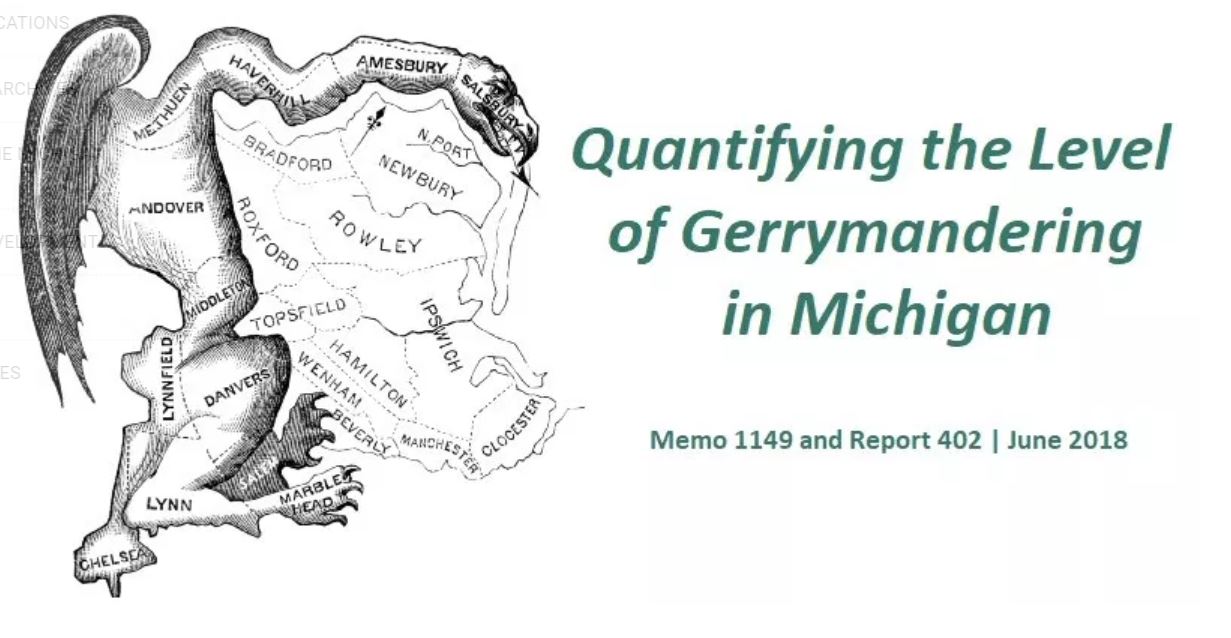Michigan IS Gerrymandered, New Study Concludes
Citizens Research Council of Michigan employes multiple statistical standards to determine extent of state gerrymandering.

Michigan’s political district are gerrymandered, according to a new report from the Citizens Research Council of Michigan.
Click HERE to download the full report.
Using a combination of statistical tests and analysis, the Council found that Michigan’s congressional and legislative district maps fail several tests that are currently being discussed to evaluate partisan gerrymandering.
Citizens Research Council President Eric Lupher spoke with WDET’s Sandra Svoboda about the study.
Click on the audio link above to listen to the edited conversation. A transcript of their full discussion appears below.
Other WDET Work on Gerrymandering:
Policy Meets the People: Introducing the Issue of Gerrymandering
LIVE STREAM: Policy Meets the People – The Redistricting Issue Special [VIDEO]
Redistricting 101: Your District, Your Politicians, But Does Your Vote Matter?
Policy Meets the People: Introducing the Issue of Gerrymandering

Eric Lupher: We set out to look at a number of measurements of gerrymandering as a way to get beyond the “eye test.” We all look at maps of congressional and legislative districts, and they look like they stretch all over. But in digging in, there’s often good reasons for that. So we wanted to get beyond that, to actually measure the amount to which the districts are skewed to help one party or another.
Sandra Svoboda: So when we look at these maps, and a lot of our audience and our listeners have been going that online. We have kind of a Rorschach test of these districts. And they’ve come up with some pretty creative things in what they see in those shapes. But what you’re saying is that a really odd shape is not necessarily an indication that partisan gerrymandering is going on?
Lupher: That’s exactly what we’re saying is that sometimes there are very legitimate reasons. We have a map in our paper of a Chicago district that looks like a pair of headsets that you might put on but in fact they were trying to keep a Hispanic community together. So you look at it and say that’s obviously gerrymandered but you look at the data and see that they were serving a very legitimate purpose.
Svoboda: So let’s talk about that data. What measurements did you use to determine that Michigan is actually indeed gerrymandered? Which is the conclusion that you reached in this Citizens Research Council paper this week.
Lupher: The first one is what’s called an “efficiency gap.” So for every district, basically Republican and Democrat candidates are the ones that going to be win most elections so think in binary terms. The efficiency gap looks at how many votes did voters of a party give that did not matter. Either they got beyond the 51 percent up to 70 percent – those are wasted votes. Or if you’re voting for the candidate that didn’t win, those are wasted votes. You didn’t get somebody into office, and so in a state like Michigan that tends to be pretty purple – neither red nor blue – it should be pretty close to zero when you event those out. A Republican district is going to have a lot Democratic wasted votes, on the other side, there are going to be wasted votes for the other party. But we looked at that and we found that Michigan looks skewed to the Republican party. That was the first one and that was the one the U.S. Supreme Court was looking at when they thought about the Wisconsin Supreme Court Case. So that was a significant test.
The next test is something called the mean-median, and this gets really into statistics and statistical matters for statisticians. Basically, it looks at the average across all the state and then how a particular district compared to that average. So again when you even things out across the whole state, you should be pretty close to an even score, but our measure using the methodology of the statistic showed that the state is skewed to the Republican party. There’s no accounting for the Voting Rights Act for geography other things that would naturally do this. That we’re so far beyond a statistical measure.
The last one is called a t-test, this gets really into the weeds but again it showed that there’s no simple way of accounting for the amount of skew in the measure of how the votes are cast and how they help people get elected that has to be accounted for by skew and how the districts are drawn.
Svoboda: How do we know that the overwhelming number of Republican wins in Michigan in recent elections is due to gerrymandering and not a lot of other factors. Did they have better candidates? Were the candidates better funded? Some other reason going on in each particular race that made that candidate a little better. How do we know it’s actually an issue with the way the district is drawn and gerrymandered.
Lupher: So in a single election you can’t know that. You have to get really in and do a lot of surveying and try to figure out why people voted the way they did. But in our analysis, we looked all the way back to 1998, every state election. That would be every congressional election, every state house election and then the state senate every four years. So over time, those things should even out, one party funding better candidates, those things are going to even out over time. Looking at that it’s pretty clear that it’s the districting that matters more than the money, more than the quality of the candidate, more than a lot of other things.
Svoboda: The Citizens Research Council of Michigan is a nonpartisan research group but you’re putting a report out on GM in an election year when we are likely to have a question on the ballot that would ask the voters whether they want to change the process – make it less political – for how these districts are drawn, and because we have such a Republican majority in Michigan, this issue has been stacked up in a lot of ways as the Republicans supporting no change and Democrats in a lot of ways supporting the ballot initiative. Why are you doing the gerrymandering report now and how are you keeping to your nonpartisan mission.
Lupher: We did this report and we think we would have done it regardless of which party was being favored. The two court case that just ruled on in the U.S. Supreme Court, the Wisconsin case favored the Republicans. The Maryland case favored the Democrats. This isn’t about one party or the other. This is about the people being represented. So we are looking at the Voters Not Politicians. Every election cycle the CRC does analysis of the ballot issues. This is part of this analysis. We didn’t want to come out at the end of the year and have a huge paper that gets into the weeds: “Is Michigan really gerrymandering, why does it all matter?” This is the first of a multipart look at the issue of gerrymandering. But we also did this because it matters in Michigan. We did a paper a couple months ago looking at Michigan’s urban-rural divide, how we’ve separated ourselves or self-sorted into different urban and rural areas and then a month ago we did a paper on term limits, how we’ve put restrictions on the people we’re electing to govern us, how we don’t give them enough time to get the expertise and to build relationships. Now this gerrymandering paper and it all fits together to say “we’re really cheating ourselves on how we allow the people we’re choosing to govern us to be effective at what they do,” and there’s consequences of that in how we’re funding schools, how we’re funding roads, how we’re doing everything we’re asking our state and our federal representatives to do the things they’re responsible for.
Svoboda: How is the conversation about gerrymandering different in 2018 that it was 10 or 20 years ago?
Lupher: I think the biggest thing is that the computers and technologies have advanced so that we can do this sort of analysis that we did in our paper that we’re able to run simulation, given different algorithms on is it natural to come up with the maps we did or is this so far to an extreme? We’re able to get into the sort of in the weeds, very tech analysis of voting results to get into there so gerrymandering has been around as long as we’ve been a nation. It comes from one of the first iterations of the exercise of drawing districts. It will be around for as long as we’re a nation. But always our constitution, our state constitution have tried to put some limits on it to say we want a fair playing field and we want people’s interests to be represented and when we move beyond that, when we allow the legislature to do as it wishes without regard to a fair playing field, then that affects us and affects our trust in government.
Svoboda: To what extent are the same technological processes that allowed you to do this paper and analyze the data being used to draw the district?
Lupher: It’s the very same thing. They’ll draw the districts and impose on those the voting records in the different communities to see who is being favored in the maps that they’re drawing. I don’t know that they necessarily get into these same statistical measures. But it’s, in essence, the same thing they’re trying to do.
Here’s other WDET work on the gerrymandering issue:
Talk Show Programming
WATCH HERE: A live one-hour show with an in-studio audience and guests at 8 p.m., Tuesday, June 26. Tune in at 101.9 FM or online at WDET.org. Or join on WDET’s Facebook page where we’ll live stream the show. The show rebroadcasts at 2 p.m. Tuesday, July 3. Listen HERE for WDET 101.9 FM live online.
On DETROIT TODAY: Was Racism Involved in the Drawing of Michigan’s Congressional Districts?
Digital Specials
A Podcast Playlist – Become a Gerrymandering Expert Just By Listening
NPR’s Hidden Brain: Gerrymandering and You
News Coverage
MichMash: Here’s How You Can Influence The Drawing of District Lines in Michigan
Gerrymandering: Why It’s a Technology Issue [TRANSCRIPT]
Redistricting 101: Your District, Your Politicians, But Does Your Vote Matter?
Ohio Offers Its Own Solution to Gerrymandering [MAPS + GRAPHS]
Who Should Draw Michigan’s Political Maps? Voters May Decide [PHOTOS + MAP]
Voters Not Politicians: The Pros [TRANSCRIPT]
Voters Not Politicians: The Cons [TRANSCRIPT]
It’s a Ship….No, it’s a House…Wait, it’s a Congressional District?
Does Michigan Have a District that Looks Like Homer Simpson? You Be the Judge.
